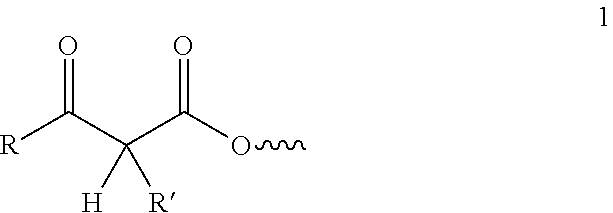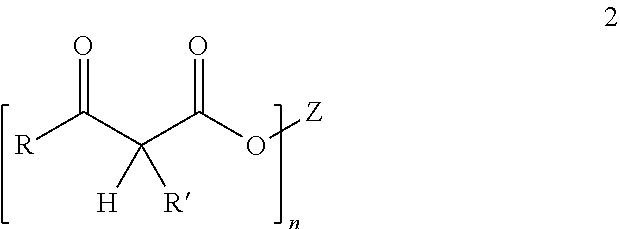Curable compositions comprising acetoacetylated resins, aldehydes and certain amines
a technology of acetoacetylated resins and curing compositions, applied in the field of polymer compositions, to achieve the effect of reducing defects and good adhesion
- Summary
- Abstract
- Description
- Claims
- Application Information
AI Technical Summary
Benefits of technology
Problems solved by technology
Method used
Image
Examples
example 1
Synthesis of Acetoacetate Functional Polyester 1 (AcAc Resin or Polyester 1)
Hydroxyl Functional Polyester 1:
[0530]A 2-L kettle with a four-neck lid was equipped with a mechanical stirrer, a thermocouple, a heated partial condenser (115° C.). a Dean-Stark trap, and a chilled condenser (15° C.). To the flask were charged neopentyl glycol (NPG) (255.9g), 2-methyl-1,3-propanediol (MPD) (221Ag), trimethylolpropane (TMP) (48.84g), isophthalic acid (IPA) (348.9g), adipic acid (AD) (306.9g), and the acid catalyst, Fascat-4100 (Arkema Inc.) (1.31g). The reaction was reacted under nitrogen at 170° C. for one hour, at 190° C. for one hour, and at 220° C. for about 3 hours to yield a clear, viscous mixture. A total of 148.8g of the distillate was collected in the Dean-Stark trap. The resulting mixture was cooled to room temperature and subsequently collected (1005g). Acid number: <1.0 mg KOH / g; hydroxyl number: 102.4 mg KOH / g; glass transition temperature (Tg): −25.1° C.; number average molecul...
example 10
Synthesis of Acetoacetate Functional Polyester 10 using Diketene (AcAc Resin or Polyester 10)
Hydroxyl Functional Polyester 10:
[0533]A 500 mL three-neck round-bottom flask was equipped with a mechanical stirrer, a thermocouple, a heated partial condenser (100° C.), a Dean-Stark trap, and a water condenser. Adipic acid (109.61 g), isophthalic acid (41.54 g), 2,2-dimethylpropane-1,3-diol (59.71 g), 2-methylpropane-1,3-diol (51.61 g), trimethylolpropane (27.24 g), and Fascat 4100 catalyst (0.29 g) were charged into the flask, which was then purged with nitrogen. The flask was heated under slow nitrogen sweep at 170° C. for 1 hour, 190° C. for 1 hour, 200° C. for 2.5 hour, 210° C. for about 0.75 hour to complete the reaction. The product was poured into a glass jar while it was still hot. The number average molecular weight Mn was 2000, and the weight average molecular weight Mw was 5000. The glass transition temperature Tg was -41 CC. The hydroxyl value was 141 mg KOH / g, and the acid va...
example 11
Synthesis of Triacetoacetate Adduct of Trimethylolpropane (TMP TriAcAc)
[0535]A 500 mL three-neck round-bottom flask was equipped with a mechanical stirrer, a thermocouple, a heated partial condenser (105° C.). a Dean-Stark trap, and a water condenser. To the flask were charged trimethylolpropane (50.0 g), t-butyl acetoacetate (167.8 g), and the catalyst, Fascat 4100 (022 g). The mixture was heated and allowed to react at 120° C. for 20 minutes and then at 140° C. for two hours. A total of 103 mL of the condensate (t-butanol) was collected in the Dean-Stark adapter. The resulting mixture was cooled and the liquid product (TMP TriAcAc) collected.
PUM
| Property | Measurement | Unit |
|---|---|---|
| Tg | aaaaa | aaaaa |
| temperatures | aaaaa | aaaaa |
| temperatures | aaaaa | aaaaa |
Abstract
Description
Claims
Application Information
 Login to View More
Login to View More - R&D
- Intellectual Property
- Life Sciences
- Materials
- Tech Scout
- Unparalleled Data Quality
- Higher Quality Content
- 60% Fewer Hallucinations
Browse by: Latest US Patents, China's latest patents, Technical Efficacy Thesaurus, Application Domain, Technology Topic, Popular Technical Reports.
© 2025 PatSnap. All rights reserved.Legal|Privacy policy|Modern Slavery Act Transparency Statement|Sitemap|About US| Contact US: help@patsnap.com


